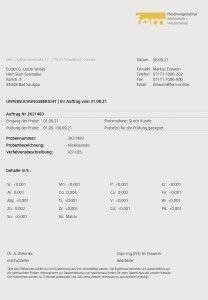-Or:- What waves a harmless cellar discovery can cause in the electroplating industry.
The beginnings of this story cannot be pinpointed exactly. They lie somewhere in the darkness of the 1970s, perhaps triggered by the oil price shock, the subsequent car-free Sundays and the Germans' yearning for really solid investments. But that is speculation and the exact when and why is irrelevant to the events described here.
 Treasure trove: Numerous sealed red buckets contained a ton of nickel in Leuze's cellar: Heinz Leuze, then managing director and owner of Leuze Verlag and always known for his foresight, decided to invest privately in tangible assets. As the publisher of "Galvanotechnik", nothing was more obvious to him than metals that were - and still are - used in electroplating. His choice fell on nickel.
Treasure trove: Numerous sealed red buckets contained a ton of nickel in Leuze's cellar: Heinz Leuze, then managing director and owner of Leuze Verlag and always known for his foresight, decided to invest privately in tangible assets. As the publisher of "Galvanotechnik", nothing was more obvious to him than metals that were - and still are - used in electroplating. His choice fell on nickel.
Some time later, a ton of nickel in the form of anodes was delivered to the Leuze family home. Neatly packed in handy, sealed buckets. And now? Where to put the heavy stuff? First into the cellar, you can't go wrong there. In fact, the gray metal was stowed away so permanently that it was just as permanently forgotten over the decades. Especially as the former publisher has long since passed away and his two daughters Sylvia and Inge have taken over the inheritance.
But at some point, as every homeowner who has spent centuries accumulating bric-a-brac, kitsch and junk in the attic, cellar and usually also in the garage knows, the day of truth comes. The day when you can no longer avoid decluttering, when you have to face the dust of time and offer your airways.
This is what happened at Leuze last summer. And alongside handbags that had long gone out of fashion, summer dresses and a homemade cardboard sign from the daughters' first school demonstration (Americans out of Vietnam!!!), the barrel of nickel also reappeared. Or to be more precise, the many buckets in Leuze red reappeared.
It doesn't take much imagination for the two of them to stare at the mysterious red containers. Should their mother's preserves still be fermenting in them? Pickled, sour herring? And if so, would the whole thing explode if the lid was unsealed and the contents came into contact with oxygen? The two women decided not to touch the explosive cargo for the time being and to first have a cigarette outside in a non-explosive environment.
They wouldn't be twins, let alone identical twins, if they hadn't come to the realization together: "That's the niggle!"
They then discussed what to do with it. Keep them even longer? Possibly, as in their own case, even pass it on to their children? Or sell it? Another cigarrette later, the decision was made. As commodity prices were quite high at the moment, they would sell the treasure trove. Now.
It is no longer possible to reconstruct the exact course of events after that decision, as the information is too contradictory. The only thing that is certain is that after 50 years, no evidence of the purchase could be found. As it had been a private purchase by the father, there were also no papers in the publisher's accounts of those years.
This is where a man comes into play, whom we will call B. C. from now on. He wants it that way, he doesn't value publicity, but he is a proven expert in the, let's call it vaguely, metal industry. That is why the heiresses commissioned him to return the nickel to the market.
No evidence available
But the expert hesitated. The main reason for his hesitation was the unclear origin of the metal.
"Sitting in a cellar for 50 years and then being rediscovered doesn't sound very credible, even if it is true," he told our magazine. And then there was also a missing certificate about the type and nature of the metal. How were the two clients to interpret the hesitation of their informer?
It cannot be said at this point that the sisters had used physical violence against their informer, but they did have some powerful arguments in favor of taking on the job.
Let's put it this way: at the end of the meeting, the arguments of the two sisters had convinced B. C.. A strategy had to be prepared. And that involved squaring the circle. For tactical reasons, B. C. wanted to avoid a potential buyer finding out that Leuze-Verlag was behind the sale. Because he knows: "When buying anodes, the price is not the most important factor. But material of unspecified quality can simply cause more technical damage later in electroplating plants than was saved when purchasing. And that could then reflect negatively on the publisher."
So the man put out feelers in the direction of the anode trade, smaller companies in particular, because things are often less complicated in small businesses. And the anode trade would also be able to analyze the metal itself relatively easily.
At this point at the latest, it became clear that by selling the nickel without papers, they had entered the realm of organized crime. The Leuze ladies finally became godmothers in the background, B. C. a fence.
"This ton is more likely to interest the criminal investigation department," the first dealer grumbled and slammed the phone down.
"A ton of nickel without papers? It's worth 9,000 euros to me, that's all," said one of the potential buyers, who does not wish to be named here. Another offered 10,000 euros, also without an invoice, and demanded discreet handling. For comparison: at the time of the sale, the nickel price was just under 17,000 euros, and the anode price was even around 21,000 euros per ton.
"That meant for me," explains B. C., "the dealers didn't care where the metal came from, it could have been stolen." Time to break off the conversation. Another dealer criticized the lack of proof of origin, but above all the lack of quality certificates. B. C., an expert on the subject, had pointed this out right at the start of the sales campaign.
The two godmothers were contacted. B. C. tried to persuade them to have the fabric analyzed. However, at the time, the clients thought it was still too early.
Analysis by the fem
 The analysis protocol of the Research Institute for Precious MetalsSochange of strategy. Now it was the electroplating plants that were approached directly and without an intermediary. But even there: no results. Eight out of ten electroplating companies did not respond at all, and two declined from the outset. One Swiss company at least showed interest, but then feared the bureaucracy at customs - with the lack of proof of origin again being the biggest problem. A third would have been overwhelmed with a whole ton, but also refused to buy 250 kg.
The analysis protocol of the Research Institute for Precious MetalsSochange of strategy. Now it was the electroplating plants that were approached directly and without an intermediary. But even there: no results. Eight out of ten electroplating companies did not respond at all, and two declined from the outset. One Swiss company at least showed interest, but then feared the bureaucracy at customs - with the lack of proof of origin again being the biggest problem. A third would have been overwhelmed with a whole ton, but also refused to buy 250 kg.
Finally, B. C. was finally able to persuade the saleswomen in the dark background to have the metal analyzed. The choice fell on the renowned Research Institute for Precious Metals (fem) in Schwäbisch Gmünd. The analysis report shows excellent results.
Equipped in this way, the social media were now also used - and again there was a shitstorm like buckshot from a mafia hitman's pump-action shotgun.
At least there were some serious contacts on Facebook and eBay classifieds. And one of them fit the bill. A few days after the events described, a car came from the far west of the republic and picked up the hot goods.
B. C. draws a mixed conclusion from the days and weeks that have passed. Some of the potential buyers acted correctly. They flatly refused to buy without papers of origin, some even threatened to call the police. In view of the numerous break-ins at electroplating companies and construction sites, this was more than understandable.
Some others, however, made no secret of the fact that they were also interested in hot goods - as long as the price was right. It didn't matter that valuable anode material was stolen from an electroplating plant in Saxony and an electroplating plant in Switzerland at the same time as these events. B. C.: "I spontaneously remembered a wise saying by Mark Twain. While the truth is still tying its shoes, the lie has already traveled around the world three times."
TO THE POINT:
"Elaborate logistics rule out spontaneous theft."
Mr. Glodek, who are the thieves of metallic raw materials, who are the clients?
 Jürgen Glodek is First Chief Superintendent and Press Spokesman for the Stuttgart State Criminal Police OfficeThefts of this kindare committed by groups of criminals who operate nationwide. The groups of offenders are mobile in small groups, often in changing occupations with transport vehicles. They usually have experience in the trade or construction industry and are therefore well informed about the value of the metals. Most of the criminal groups come from southern/eastern European countries.
Jürgen Glodek is First Chief Superintendent and Press Spokesman for the Stuttgart State Criminal Police OfficeThefts of this kindare committed by groups of criminals who operate nationwide. The groups of offenders are mobile in small groups, often in changing occupations with transport vehicles. They usually have experience in the trade or construction industry and are therefore well informed about the value of the metals. Most of the criminal groups come from southern/eastern European countries.
It can be assumed that this type of crime corresponds to the economic market in Eastern European countries and is based on the principle of need and demand. It is not known whether there are specific clients who communicate their needs.
Are there certain types of victims?
Metals are stolen from easily accessible locations and at favorable opportunities. Raw materials from building sites or external company warehouses are popular in this area of crime. Occasionally, railroad systems, copper roofs, grave markers or other assembled metal constructions are also stolen. The theft of special metals for certain application techniques, as described in your case, tends to play a subordinate role.
Who are the buyers, where are the markets?
On the one hand, there are bona fide purchasers, such as a local scrap metal dealer, and on the other hand, fencing structures have come to light that enable more targeted marketing and thus higher proceeds. In order to legalize the metals, documents such as freight documents or invoices are sometimes falsified and individual characteristics altered. There is a global demand for raw materials. It can be observed that the stolen goods are increasingly being sold abroad, mostly in the home countries of the perpetrators.
Is this organized crime or spontaneous action?
Due to the complex logistics and preparation alone, spontaneous action can be ruled out in the majority of cases and a division of labor can be assumed. Classification as organized crime (OC) regularly requires the fulfilment of precisely defined OC criteria after consultation with the public prosecutor's offices. We examine whether and in what form these criteria are met in each individual case.
Are commodity shortages and rising prices fueling unlawful actions?
As the commodities market is not the subject of police investigations and observations, no statement can be made on this.
How high is the annual damage caused by such thefts in Germany and Europe?
I can only give an annual figure for Baden-Württemberg. In recent years, the police crime statistics in Baden-Württemberg have recorded losses of around 2,900,000 euros per year caused by the theft of metals. The metals taken into account here are aluminum, lead, bronze, iron, copper, brass, steel, zinc and tin. Precious metals, such as gold and silver, are not included.
What is the clearance rate?
In the past five years, the average crime clearance rate in the Baden-Württemberg police crime statistics was around 23%.


